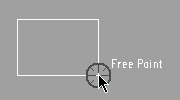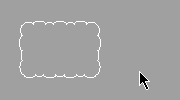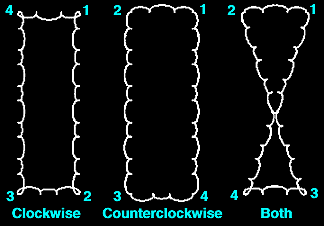 Cloud Add ( Drawing Editor > F7 )
Cloud Add ( Drawing Editor > F7 )
Tool summary :
Also see :
- Drawing Editor (where Cloud Add is a tool)
- Clouds (topic)
- Cloud Edit (window)
- Cloud pen color (sets pen for auto detailed clouds)
- Layer Panel (drawing layer the cloud is added to)
page 1 | contents | objects > clouds > | objects -- clouds | xxx add | clouds
 Example 1 : Click and drag to draw a rectangular cloud
Example 1 : Click and drag to draw a rectangular cloud
| Tip: Clouds added at an angle may be difficult to Shorten . Using this method to add a cloud ensures that it will be rectangular and will properly Shorten . |
|

|
1 . Click and drag, moving your mouse pointer ( |

|
2 . When you release the left mouse button, the rectangular cloud is drawn. |
page 1 | contents | objects > clouds > | objects -- clouds | xxx add | clouds | top
 Example 2 : Drawing clouds by locating points
Example 2 : Drawing clouds by locating points
|
|
page 1 | contents | objects > clouds > | objects -- clouds | xxx add | clouds | top
 Step-by-step instructions (for adding a cloud by locating points) :
Step-by-step instructions (for adding a cloud by locating points) :
The following instructions assume that you are using a 3-button mouse.
1 . Before using this tool:
1a (optional) : By default, the cloud will be added to the ' User Annotations ' drawing layer. On the Layer Panel, optionally set a different layer that you want to add the cloud to be added to.
1b (if applicable) : Unshorten a member detail before adding a cloud if you want Detail Members to later be able to correctly preserve ' User-created ' annotations. For best accuracy in any type of Drawing Editor drawing, you can count on measurement tools such as Dimension Add or Ruler or Construction Line Add using BSCL to reliably produce precise and consistent results in an unshortened drawing.
1c (optional) : To set the defaults for the to-be-added cloud to be those of an existing cloud, double-click the existing cloud then press " OK " on its edit window.
2 . Invoke Cloud Add using one (1) of the following methods:
Method 1 : Click the Cloud Add icon. The icon can be taken from the group named ' Objects -- Clouds ' and placed on a toolbar (classic) or the ribbon (lightning).
Method 2 : If " Drawing Editor layout style " is ' Classic ', you can use the menu system to choose Objects > Clouds > Add .
Method 3, 4 or 5 : Cloud Add can also be invoked using a keyboard shortcut , the context menu , or a mode . For the ' Lightning ' layout style, configuration of the interface is done using Customize Interface .
3 . Locate - Remove - Return mouse bindings become active along with various Locate options.
|
|
|
bindings |
Alternative 1 : With FRPT the selected Locate option, click and drag, moving from left to right, to draw a rectangular cloud as shown in example 1 . Go to step 4.
Alternative 2 : places an X where you locate the point. Locate Cloud Add ). Locate ) snaps to where you want one of the perimeter points of the cloud, then left-click (
( point location target ) so that the
that you want (if it's not pressed already), then place the mouse pointer ( Locate icon Select the at least two additional points (moving counterclockwise as shown in the example 2 to define the perimeter of the cloud). If you lay out too many points, you can middle-click ( Remove ) to delete the last one. Right-click ( Return ) when you are done defining points. Go to step 4.
4 . The cloud is drawn on screen, and Locate - Remove - Return mouse bindings become active. Do one (1) of the following:
|
|
|
bindings |
Alternative 1 : Optionally change the line type and pen (step 1), and repeat step 3 to draw additional clouds.
Alternative 2 : If you are done adding clouds, right-click ( Return ). Go to step 5.
5 . The mouse bindings that were active when you invoked Cloud Add become active again.
Note: Any clouds added using this procedure can be instantly removed (one at a time, in reverse-order of their addition) by using Undo .
page 1 | contents | objects > clouds > | objects -- clouds | xxx add | clouds | top








